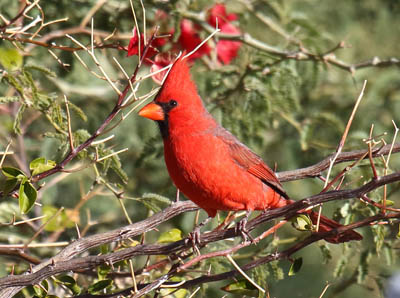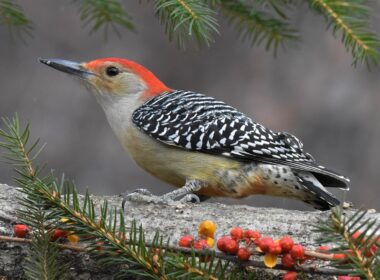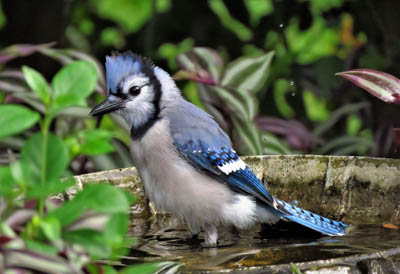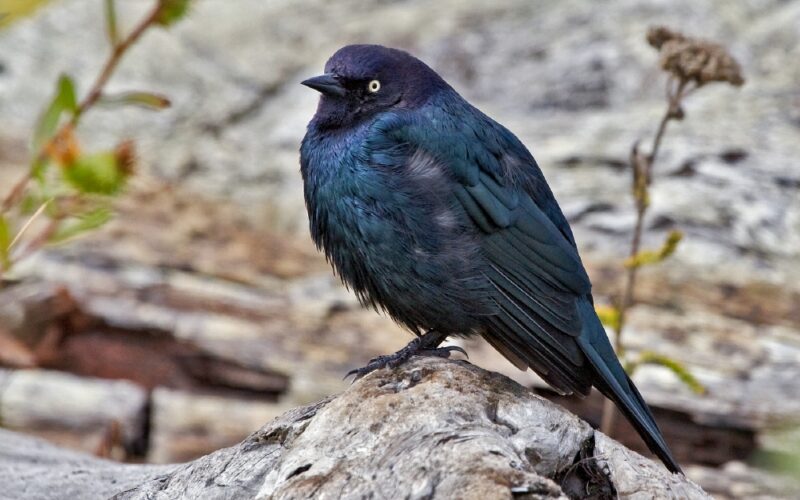Last Updated on January 12, 2024 by Greg Gillson
Are your feeders being overrun with grackles, blackbirds, and starlings? What can you do about it? I hope to offer some ideas that provide you some relief.
Even if you can’t identify them exactly, these dark birds are larger than your other feeder visitors. They come in large flocks and chase other birds away. They have voracious appetites! They can empty your feeders in minutes!
How can you get rid of these unwelcome bullies and keep them out of your bird feeders?
There are 4 effective ways you can get rid of grackles, blackbirds, and starlings at your feeder:
- Change the types of feeders you use
- Change what foods you feed birds
- Change the bird houses in your yard
- Do some home maintenance
 |
|
A flock of blackbirds ready to descend on your bird feeder!
Photo by Greg Gillson
|
Is this a seasonal issue or do you have blackbirds all year?
Common Grackles can be a problem in the East. They are resident in the Southeast and can be a problem all year. Elsewhere Common Grackles are migratory in the Northeast, Midwest, eastern and central Canada, and the Great Plains. Grackles in these latter locations might only be a problem in spring or fall migration.
Red-winged Blackbirds generally only visit feeders in the winter. They move to the marshes to breed in the summer. Brewer’s Blackbirds in the West and Rusty Blackbirds in the East only form large flocks in the fall and winter. They also migrate northward in the summer.
European Starlings, Boat-tailed Grackles in the East and Great-tailed Grackles in the West are non-migratory. So they can be a problem all year.
If anyone has trouble with Yellow-headed Blackbirds, well, I’m jealous! They are migratory, too.
If your problem is a seasonal issue the solution is still the same. But you may not have to apply these remedies all year. There may be some times of the year you don’t have to be so aggressive in getting rid of these birds and keeping grackles, blackbirds, and starlings away from your bird feeders.
 |
|
Common Grackles at hopper feeder
Image by PublicDomainPictures from Pixaby
|
1. Change the type of feeders you use
There are several changes you can make to your bird feeders to help get rid of unwanted blackbirds, starlings, and grackles.
First of all stop using platform feeders. These are open to all birds with a wide shelf for them to stand on and eat. Numbers of birds can share the platform at the same time. This makes it easy for flocks of starlings or grackles or blackbirds to consume all your food in short order.
Switch to tube feeders. Find tube feeders without trays at the bottom so that these larger grackles have no place to stand.
Some of these tube feeders don’t even have perches. Others have removable perches just to solve this blackbird problem. There are some tube feeders with feeding ports under the perches! Finches and nuthatches and chickadees have no trouble hanging upside down to feed from these. Starlings will fall off these types of feeders, or at least have a very difficult time hanging on to get to the food.
Another type of tube feeder is enclosed in a metal cage. Smaller birds like chickadees and finches go right through the bars. Larger birds and squirrels can’t get in. This is very effective in keeping bigger grackles and blackbirds and most starlings out of the feeder. It also keeps out jays. Some birds such as cardinals and grosbeaks may also have a difficult time getting in, though. And it doesn’t keep out chipmunks.
Try some squirrel-proof hopper feeders. These feeders have weight-activated perches that close when a heavy squirrel gets on them. Find such feeders that allow you to adjust the weight sensitivity.
Blackbirds may weigh 3 to 4 times as much as a finch or chickadee. Such adjustments will, however, also keep out jays and cardinals, too. Perhaps an added benefit is that the feeder ports will close if a whole flock of small birds get on the feeder at once. This will allow only a limited number of birds to eat at a time–perhaps saving you bird food costs!
Look for an upside-down suet feeder. These have a roof over the top. Birds must fly up under the feeder and hang on to eat. This is no problem for wrens and titmouses and nuthatches. Even the largest of the woodpeckers can get to the suet with ease. But grackles and starlings have a very difficult time eating from these types of suet feeders. .
Related: 7 Kinds of bird feeders and the birds that like them
 |
|
Molting male Brewer’s Blackbird eating bread
Photo by Greg Gillson
|
2. Change what foods you feed the birds
Don’t feed birds cheap mixed seeds! These mixed seeds are derived from the poultry industry where “chicken scratch” is cheap and sold as bird food. Stay away from foods with milo, oats, wheat, and cracked corn. Quail, doves, house sparrows, cowbirds, and blackbirds like these ingredients. Other birds? Not so much. Or not at all. If milo is listed first in bird seed ingredients, don’t buy it!
Birds pick through mixed seeds looking for their favorites. The stuff they don’t want to eat? They kick it out on the ground under the feeder, attracting grackles, blackbirds, and starlings.
Place one kind of bird seed in each feeder. That way birds won’t kick out seeds they don’t like. And birds that don’t like that single seed will stay away from that feeder.
Like most seed eating birds, starlings like sunflower seeds. But their bills are rather weak for cracking them open. Striped sunflower seeds are especially difficult for starlings to open. This is likely true for other blackbirds and grackles. So, switch to striped sunflowers in your feeders. Save the black oil sunflower seeds for tube feeders that blackbirds have a hard time eating from.
Next to sunflower seeds, most birds like white proso millet, including blackbirds. If your problem with these large bully black birds is seasonal, put off feeding bird seed with millet during the season they invade.
Safflower is a seed with a hard shell. Cardinals and chickadees will eat safflower. Grackles and starlings will probably leave it alone. An added benefit is that most squirrels don’t like safflower seeds, either!
Niger seed, often sold as thistle is a favorite of goldfinches and small finches. The Grackles, blackbirds, and starlings don’t like it.
Consider a nectar feeder for hummingbirds and orioles. Blackbirds won’t bother.
If you feed suet, try plain suet without nuts, seeds, or fruit. Starlings aren’t supposed to like plain suet as much. But it will still appeal to woodpeckers. And remember the upside-down suet feeder we discussed in the previous subheading. I never knew there were so many varieties of suet!
 |
|
Male Red-winged Blackbird at suet feeder
Photo by Greg Gillson
|
Getting rid of grackles, starlings and blackbirds–and keeping them away–may be about what not to feed them. Have you noticed that these birds hang around the dumpsters at McDonalds and other fast food restaurants? If you want to keep these birds away–don’t feed them kitchen scraps!
Don’t feed birds bread. They’ll eat it. It fills them up. But they don’t get much nutrition from it. This includes crackers, tortillas, cake, and other wheat flower products.
Don’t feed birds meat scraps. It invites the wrong kind of birds,… and rodents.
If these pest birds are using your bird baths, you might want to consider letting the bird bath go empty for a while. At least until you see if the changes to feeders and foods start to work.
3. Change the bird houses in your yard
This and the next tip are specifically for keeping starlings from nesting in your yard.
Starlings are notorious for taking over nest boxes from other cavity nesting species. The largest nest box entry hole size should be 1-1/2 inches in diameter. This allows bluebirds to nest. Barely. Sometimes starlings can still squeeze in.
If you don’t live in the country next to large open pastures, you probably don’t have bluebirds. In this case, go down to an entry hole size of 1-1/4 inches.
Wrens and chickadees will still be able to nest.
Starlings can enlarge the entry hole if the wood is soft. Woodpeckers might too. When the woodpeckers enlarge the entry hole, the starlings chase away the woodpeckers! You can buy metal entry hole guards that birds can’t enlarge.
Remove perches from nest boxes. Smaller birds don’t need perches. Perches allow predators (including starlings) to hang on the nest box. It makes it easier for them to get at the eggs or nestlings inside. A perch will make it easier for starlings to land and enlarge the entrance hole.
 |
|
Breeding plumage European Starling at bird bath
Photo by Greg Gillson
|
If you have a larger tree with hollow branches or trunk, starlings will nest there, too. I would keep the tree up for other cavity nesting birds. Only one pair of starlings is likely to nest in your yard. Maybe.
Before I’d chop down a tree I would try changing the foods and feeders first, as specified above. You might try some netting, though, especially if the starlings are eating fruit from your tree.
4. Do some home maintenance
This tip is for European Starlings and House Sparrows. They nest inside your home. They get in through vents and holes in your siding.
Make sure you don’t have any gaps or holes in your siding. Repair any trim that exposes any cracks or seams. Add new screens to ventilation holes if they are missing, torn, or damaged. Basically, screen off or block any holes. This will keep out starlings and house sparrows as well as rodent pests.
Common Grackles build bulky nests in conifer trees–dense spruce or other similar small trees.
The Boat-tailed and Great-tailed Grackles as well as Red-winged and Yellow-headed Blackbirds nest in marshes and aren’t usually in residential areas in summer. Of course, that is unless you live near a marsh or wetland!
 |
|
Great-tailed Grackle on a lake shore picnic table
Photo by Greg Gillson
|
Wrapping Up
So, my advice is pretty simple after all that:
Change your food and feeders to make it harder for these bigger birds to feed from. Experiment with different types of feed to see what the bullies don’t like and the birds you want to see more of, do. You should be able to get samples of different feeds from your local store.
Seal up any potential nest sites in your home for starlings.
Frequently Asked Questions
How do you scare grackles but not other birds?
Scare tactics for grackles can be tricky, as ideally you want to deter them without impacting other bird species. Here are some methods that may be more effective at deterring grackles while minimizing the impact on other birds:
Predator decoys: Placing realistic hawk or owl decoys near your feeders or roosting areas can spook grackles, as they are natural prey for these predators. However, choose static decoys over moving ones, as the latter may also alarm other birds.
Reflective objects: Shiny objects like hanging CDs, metallic ribbons, or mirrors can disorient grackles, causing them to avoid the area. However, ensure they are placed strategically to target grackles’ preferred perches without reflecting directly on feeders where other birds may be.
Scarecrow-like figures: Creating a scarecrow-like figure with dangling reflective objects or CDs can also be effective.
Do wind chimes scare birds away from feeders?
Whether wind chimes scare birds away from feeders depends on several factors, making it a somewhat unreliable solution for bird control. Here’s a breakdown of the pros and cons:
Potential to scare birds:
- Loud, sudden sounds: Some wind chimes, especially ones that produce loud clanging noises, can startle birds, causing them to temporarily avoid the area where the sound originates. This may deter them from accessing nearby feeders, especially initially.
- Unfamiliar movements: Birds are generally cautious of unfamiliar movements, and the swinging chimes may be perceived as a potential threat, leading them to keep their distance.
- Reflective surfaces: Chimes made of shiny materials like metal or glass can create flashes of light as they move, which can disorient or frighten some birds.
Limitations and drawbacks:
- Habituation: Birds are intelligent creatures and can quickly adapt to new stimuli. After the initial surprise, they may simply learn to ignore the chimes and continue accessing the feeders.
- Ineffectiveness against persistent birds: Certain bird species, like grackles or starlings, are known for their boldness and may not be easily deterred by the sounds or movements of wind chimes.
- Impact on other wildlife: The sounds and movements of chimes may also disturb other animals like squirrels or small mammals that enjoy visiting feeders.
- Aesthetic considerations: The presence of wind chimes may not be aesthetically pleasing to everyone, especially if they clash with the overall ambiance of your garden or feeding area.
Do plastic owls keep birds away?
The effectiveness of plastic owls as bird deterrents is a bit of a mixed bag. While they might offer some initial success, their impact is often temporary and depends on several factors:
Short-Term Shock Value:
- Plastic owls can initially startle birds with their unfamiliar appearance, causing them to avoid the area for a short period. This is due to birds’ natural caution towards potential predators.
Habituation and Ineffectiveness:
- Over time, birds become accustomed to the static plastic owl, recognizing it as a non-threatening object. This can happen within days or weeks, rendering it ineffective as a deterrent.
- For bolder species like crows, grackles, or starlings, the plastic owl may not even cause an initial scare, making it completely useless in these cases.
Placement and Movement:
- Placing the owl strategically in areas where birds frequently land or perch can enhance its initial impact. However, leaving it in the same spot for extended periods will inevitably lead to habituation.
- Some plastic owls come with rotating heads or blinking eyes, creating a sense of movement that can extend their effectiveness for a longer duration compared to static models.
Alternatives and Responsible Strategies:
- Consider predator decoys like hawks or falcons, which may be more effective than owls due to their predatory nature.
- Reflective objects like CDs or metallic ribbons can disorient birds and deter them from landing.
- Modifying feeders to accommodate specific seed sizes or types can exclude unwanted birds while welcoming smaller species.
- Removing potential perches near feeders can discourage unwanted birds from accessing them easily.
Remember, responsible birdwatching practices involve minimizing disruption and harm to any bird species. While plastic owls may offer a quick fix, relying on them can often be ineffective and short-lived. Consider utilizing a combination of alternative methods and habitat modifications for a more sustainable and ethical approach to controlling bird access to your feeders.







Great ideas. I am still trying different feeds and feeders. Must be a lean winter though, the blackbirds & grackles never used to eat the safflower, but the last month they have eaten everything I put out there. They have even been working hard trying to get into the caged feeders. Maybe as summer comes, things will return to normal. Thanks for the advice!
They must really be hungry to eat the hard safflower seeds!
You've got caged feeders for some seeds. You may try smaller white millet in more open feeders. These seeds are usually too small for the larger blackbirds, grackles, and starlings.
They may soon break up out of winter flocks and into breeding pairs. They may not be such a nuisance then.
Rew Winged Blackbirds are also eating the safflower seeds, the grape jelly we put out for the Orioles and are now trying to get at the nectar from the hummingbird feeders.
Wow. They sound like they're being a nuisance.
I can only suggest patience and wait for them to begin nesting and perhaps leave your feeders alone.
You are doing all the right things.
I currently have 3 upside-down suet feeders in which I only put "woodpecker suet". My problem Starlings and Blue jays have learned how to grab and hang upside down and feast. Very frustrating because they scare away others when their mobs show up.
Oh, that is too bad! I have an upside down suet feeder (and a regular suet cage). The Steller's Jays try, bat can't really get much from the suet feeder. There is one Starling that hangs on a bit better than others. Still, the upside-down suet feeder seems to work pretty good for them.
Is one of you suet feeders better at deterring the undesirable birds? Perhaps just keep that one up.
Or, stop feeding suet for the summer. I've noticed that chickadees, nuthatches, and other smaller birds have pretty much left my suet feeders right now. They'll be back in September.
I have finally come up with the solution. It works 100% of the time and it's so simply you wouldn't believe it. It's not a cage feeder and has no moving parts. I originally made it to keep grackles away from the meal worm feeder for the blue birds but I'm also now using it on the small bird feeder. You'll have to make it yourself as AFAIK nothing like it on the market. It's extremely easy to make.
You teased us, but didn't tell us what it is!
Believe it or not my husband and I literally made it so hard for the starlings they eventually gave up. Now the grackles are here. Will harrass them too and see if it works again
That might be entertaining for the neighbors to watch!
So much for blackbirds won't eat safflower seeds! They seem to enjoy it as much as black oil sunflower seeds. I generally have 15-20 cardinals at my feeders, that is until the blackbirds fly in!
Oh no! You may need a feeder with a weight-sensitive perch. That way only one or two larger birds at a time can eat at the feeder.
Regarding commentary by:
"Anonymous June 13, 2021 at 1:58 PM,"
as to how to keep grackles out of mealworm feeders, was that secret solution ever disclosed to you? If yes and you have shared that solution within another one of your articles, could you forward that article's link to me, Greg? I'd love to know that remedy as well!
No, Barry, that person who teased a solution never re-posted.
A caged bird feeder can work. Try to find one for suet or even meal worms.
But here's what I found on Amazon:
A caged bird feeder for suet or meal worms designed to keep out starlings and grackles.
By Erva meal worm barrier guard feeder:
Amazon affiliate link:
https://amzn.to/3q45Sv5
Thank you this is all GREAT info.
Question I would like to keep the few blue jay's and cardnels that we have will they eat from the upside down feeders or do I need to get something special for them that the grackles won't eat from?
Jays and cardinals will have difficulty with upside down feeders.
Cardinals will eat safflower seeds which grackles aren't supposed to like very well.
I would suggest looking at Duncraft also, they have many different feeders, some only will let small birds in. Plus, they are based in the USA and many of their own products are made in the USA.
I am going to try the safflower seeds, we started having a problem with Starlings about a week ago, they are chasing the little birds away. But, we have cardinals also, trying to find a way to keep them while getting the Starlings to go.
Thank you for your tips. I'd be interested in hearing the results of your safflower experiment in discouraging starlings while continuing to encourage the cardinals.
The problem with those feeders, are in line with other articles I’ve read.. They will prevent cardinals and Groesbeaks. We have mating cardinals here all year round and i don’t want to prevent them from eating. As for food changes, I’ll try the striped sunflower seed that grackles have major difficulty cracking open. Also, seems as though the safflower seed is a bust to prevent grackles.
Yes, the cage will prevent cardinals and grosbeaks from reaching the food, as you said. Safflower didn't work? Drat!
Great ideas all! thanks for posting this.
I am seriously thinking of a slingshot, maybe ice cubes for the ammo? Too sting only, not to kill. But I want them to be a tad wary of this particular yard.
Anyone ever try scarecrows, or noise making machines? I played the calls of a hawk through my loudspeakers, but that didn't seem to phase them much.
Keep your comments to yourself! Oh, what am I saying, you did keep your comment to yourself, or at least the most important part of your comment! The 100% guaranteed solution you swore would work and then proceeded to completely ignore telling us, your audience. You pud!
Thank you for all of your great information! I am just starting birdfeeding for the winter cause I live where it snows. Today I watched a squirrel trying his best to get in my cheap tube feeder. He chewed away the tree perch I added for birds and pulled it out. But he couldn't get much food. You know why? I have the tube on a tree not hanging to long with the string so he has to hang upside down while swinging. And then I did not follow it, but only to two bottom layers almost to the third level. Now this is a big squirrel. But the access to the bottom holes are difficult for him while swinging and stretching 🤣
Also to add: I have a hopper type metal feeder also that closes with pressure. He hung on that also upside down and was able to get some food from the shutter cause bird crumbs were on it. And also some from the holes before it shuts. It is a small one but the birds like it. It took overnight for the birds to come as I put them out last night. I am so happy. I had made one from dollar store material and they didn't come at all. Plus I had cheap food with mostly fillers and I read one of the articles here. So I returned them and got the food with fruits and buts mix and they love it. I will put more types up as I will continue to make my own just have it placed all over my lawn and sees what happens. I always kept water for the animals in many spots of my yard so they good on that. I love the blue Jays so I am hoping they come cause they always around I want to feed them too!